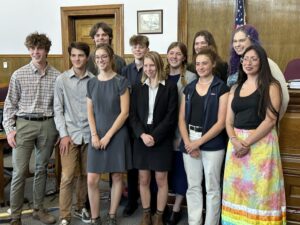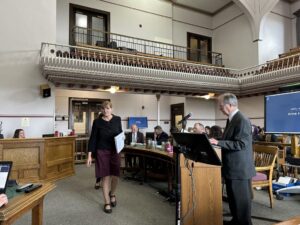By Anne Hedges
 Eleven of the 16 plaintiffs after Day 5 of the trial. Image via Daily Montanan.
Eleven of the 16 plaintiffs after Day 5 of the trial. Image via Daily Montanan.
When 16 young Montanans sued the state over its failure to consider the climate crisis, most folks had no idea that the trial would be such a powerful experience. Those who participated in cheering on the kids every day as they walked into the courtroom felt a rare sense of community and hope. Many of us sat mesmerized as we listened to expert after expert tell of the harm that is occurring across the state by a rapidly changing climate, or detail Montana’s oversized influence on the global climate, or provide a succinct analysis of the solutions that are available today to stabilize the climate system and save Montanans billions of dollars in the process. It felt like we were privy to a college-level course on climate science, Montana political history, energy systems, and the myriad solutions that are available right now. It was one of the greatest honors of my life to tell the court about MEIC’s history of trying to convince the state legislature, governors, courts, and administrative agencies that they had a duty to address our fossil fuel-fired climate catastrophe and implement solutions.
But nothing was more powerful than the testimony of the 16 youth plaintiffs. They were as impressive as they were brave in telling their stories about the impact the climate crisis is already having on their lives, their families, and their cultures. Relaying their fears for their future brought tears to many an eye in the room. Their heartfelt testimony was a devastating but powerful indictment of the disaster that politicians have perpetrated by choosing powerful moneyed fossil fuel interests over the well-being of present and future generations of Montananas and the environment that supports us.
“I know that climate change is a global issue but Montana needs to take responsibility for our part in that. We can’t just blow it off and do nothing about it,” plaintiff Eva L. said. “Just one step in the right direction would be most important.”
“It’s really scary seeing what you care for disappear right in front of your eyes,” plaintiff Sariel Sandoval said.“We wouldn’t be here without the land. It feeds us, it shelters us. It takes great care of us, and we need to take great care of it, too.”
Sandoval is a member of the Confederated Salish and Kootenai Tribes and said that Native communities “have lived through genocide, assimilation, relocation, termination, and so many other traumas. We can definitely adapt and survive climate change, but that doesn’t make it right.”
The seven-day trial kicked off with the testimony of the youngest delegate to the 1972 Montana Constitutional Convention. Mae Nan Ellingson relayed the history of the convention and the determination by the delegates to ensure that Montana’s constitution was the most environmentally protective constitution in America. The right to a clean and healthful environment was not just a meaningless afterthought. It was a provision that was created by delegates such as Bob Campbell who argued strenuously over how to craft language that would clearly relay that environmental harm was supposed to be prevented, not just mitigated after harm had occurred.
The State’s complete lack of a defense was discouraging, to say the least. It wasted untold sums to hire experts to deny climate science, misrepresent the economic impacts of changing course and investing in a clean energy system, and undermine the youth’s claims. But at trial, the State only called one of those high-paid witnesses, who admitted he was paid $500 an hour. Our Children’s Trust attorney Phil Gregory demonstrated that the so-called expert had poor math skills, no scientific basis to his analysis, and no sources for some of his most damning claims. His testimony was shredded, and the judge ruled his testimony was “not well-supported, contained errors, and was notgiven weight by the Court.” All the State had were a couple of nice employees who talked about their kids. The director of the Department of Environmental Quality even admitted that he had never heard of the Intergovernmental Panel on Climate Change until he heard testimony the previous week. The other agency head said she wasn’t qualified to say if humans were influencing the climate. Both state employees admitted they were just following the Legislature’s orders by ignoring climate change in their decisions to permit coal, oil, and gas resources. In the end, the state spent a bundle of taxpayer money and yet failed to spend more than a few hours defending its indefensible position.
In all, it was an uplifting – yet frightening – experience. It was incredibly moving to watch these young people bear their souls, discuss their impressive accomplishments, and describe their vision for the future, Many thanks to the brilliant legal team who brought this case, especially Roger Sullivan and the Western Environmental Law Center (WELC)’s Barbara Chilcott and Melissa Hornbein. Also thanks to Shiloh Hernandez, who not only represented MEIC on many of the court cases that demonstrated how difficult it is to get justice for the climate under Montana’s laws, but who also helped bring the case when he was at WELC. And thanks to the amazing team at Our Children’s Trust for their vision and talent in making this case happen.
MEIC’s Anne Hedges took the stand on Day 4 of the trial. Image via Daily Montanan.
Judge Rules in Favor of Montana Youth
Just in the nick of time for our Down to Earth deadline, Judge Kathy Seeley ruled in favor of the plaintiffs in the landmark youth climate case Held v. State of Montana on August 14. The judge ruled that the state has violated their right to a clean and healthful environment by ignoring the climate crisis.
The court determined that two 2023 legislative changes to the Montana Environmental Policy Act (MEPA) are unconstitutional because they prevent the State from considering or addressing the climate crisis and its impacts on Montanans and our environment.
While this will most likely be appealed, this is a huge win for Montana and for the nation. It’s past time for our State to fully consider and address the climate impacts from our outdated energy system.
We’ll have more details in a future issue. You can read the decision on our website.
This article was published in the September 2023 issue of Down To Earth.

